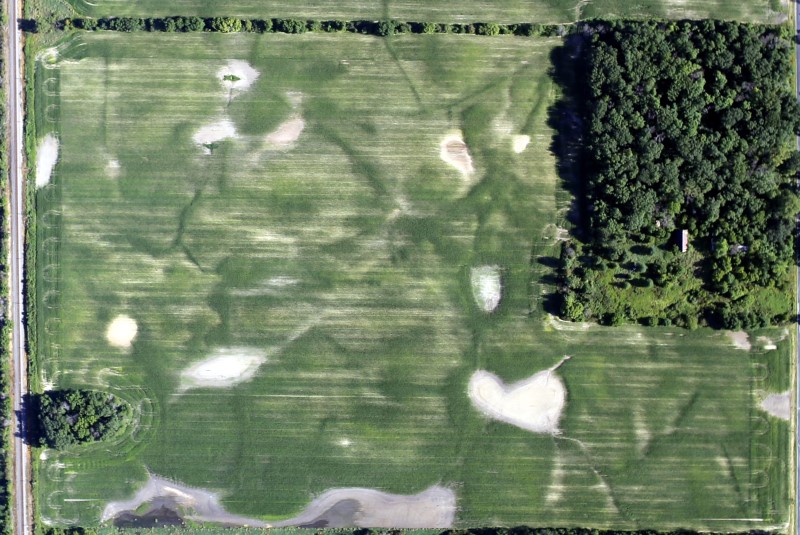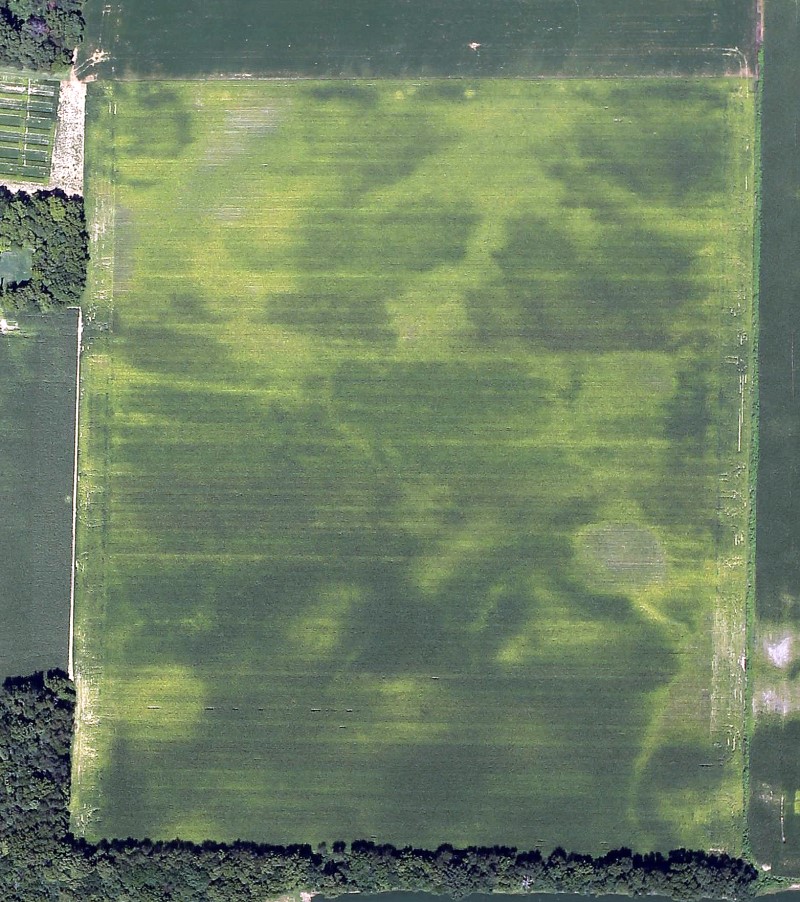
Variable growth of corn crop in early August due
to excessive rainfall earlier in the growing season.
Image source: Airscout.com.

Variable growth of corn crop in early August due
to early season excessive rainfall and late
sidedress N application. Image source:
Airscout.com.

16 Aug 2015
URL: http://www.kingcorn.org/news/articles_15/YldMonCalibr_0816.html
Yield Monitor Calibration Will Be Challenging This Year in Some Indiana Fields
R.L. (Bob) Nielsen
Agronomy Dept., Purdue Univ.
West Lafayette, IN 47907-2054
Email address: rnielsen
at purdue.edu
Understand this one simple fact about yield monitors: They do not measure yield.
How's that for an opening statement?
What I want you to understand is that yield monitors ESTIMATE yield by converting electrical signals received from a mass impact or optical sensor in the clean grain elevator into ESTIMATES of grain flow (lbs) per second or two of travel time. Along with ESTIMATES of distance traveled (usually based on DGPS positions), header width, and ESTIMATES of grain moisture content... the yield monitor's firmware / software then CALCULATES "dry" grain yield per acre at a moisture content of your choice that are logged every second or two in the display's memory or uploaded by cellular connection to a Cloud-based Web server.
Yield monitor calibration involves a series of steps to ensure that the ESTIMATION of each of these factors is accurate. One of those steps involves the harvesting of calibration "loads" of grain that are used to "teach" the yield monitor's "black box" how to accurately convert the electrical signals from the sensors into ESTIMATES of grain flow rates.
The calibration "loads" should be harvested in such a way as to mimic the range of grain flow rates (i.e., the range of yield) you expect to encounter when harvesting a field. Ideally, each calibration load is calibrated at a different, but uniform grain flow rate. Some folks harvest strips at different speeds to accomplish this. Some folks harvest strips of varying widths (full header, 3/4 header, 1/2 header, etc.). In our field-scale nitrogen research trials where we have a wide range of N rate strips, our calibration loads typically come from 5 to 6 different N treatment rates because that often gives us a wide range of grain flow rates.
The challenge this year in accurately calibrating grain flow estimates of yield monitors will be in those fields that suffered extensive damage from excessive rainfall early in the season. Yield will vary dramatically throughout such fields, maybe as great as 200 bushels per acre. It will be difficult to harvest calibration loads at uniform grain flow rates to obtain an accurate range of grain flow rates for yield monitor calibration. Similarly, grain moisture will vary dramatically within some fields where crop development was seriously delayed due to saturated soils or where areas were replanted. Combine moisture sensors can usually be adjusted to accurately estimate grain moisture content within a narrow range of moisture. However, it is my experience that moisture estimates become less accurate when the combine encounters hybrids or areas of fields with significantly different grain moistures. Inaccuracies in grain moisture estimates influence the accuracies of "dry" grain yield by the display.
The bottom line is that extra care and attention to details will be important when calibrating yield monitors this fall. Dig out that users guide for your yield monitor system NOW. Before the end of summer, devote some quality time to reading the sections on yield monitor calibration. Familiarize yourself with all aspects of yield monitor calibration. Attend a yield monitor workshop. Create your own checklist of calibration steps and follow them faithfully every time you calibrate the monitor. Do not forget the little things like vibration settings, header height stops, offset of the DGPS antenna, etc. Recognize that accurate weighing devices (grain carts, weigh wagons, farm scales) and moisture meters are crucial for the calibration of the monitor’s wet weight estimates and adjusting the combine’s moisture sensor readings.
And remember the old adage about computers… Garbage in equals garbage out.
Related Reading
Ehlert, Tyler. 2015. Harvest Both Crops and Data This Fall. Precision Point Blog, Ag Leader Training & Support. http://www.agleader.com/blog/harvest-both-crops-and-data-this-fall [URL accessed Aug 2015].
Hest, David. 2015. Calibrate yield monitors more often. Corn and Soybean Digest, Penton. http://cornandsoybeandigest.com/corn/calibrate-yield-monitors-more-often [URL accessed Aug 2015].
Khosla, R., and B. Flynn. 2008. Understanding and Cleaning Yield Monitor Data. in Soil Science Step-by-Step Field Analysis, 113–30. Madison, WI: Soil Science Society of America. http://dx.doi.org/10.2136/2008.soilsciencestepbystep.c9 [Access requires SSSA membership subscription or "pay per view" session.].
Luck, Joe and John Fulton. 2014. Best Management Practices for Collecting Accurate Yield Data and Avoiding Errors During Harvest. Univ. Nebraska Extension publication EC2004. http://www.ianrpubs.unl.edu/epublic/live/ec2004/build/ec2004.pdf [URL accessed Aug 2015].
Nielsen, R.L. (Bob). 2010. Yield Monitor Calibration: Garbage In, Garbage Out. Corny News Network, Purdue Univ. Extension. http://www.kingcorn.org/news/timeless/YldMonCalibr.html [URL accessed Aug 2015].

